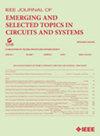GenPolar: Generative AI-Aided Complexity Reduction for Polar SCL Decoding
IF 3.8
2区 工程技术
Q2 ENGINEERING, ELECTRICAL & ELECTRONIC
IEEE Journal on Emerging and Selected Topics in Circuits and Systems
Pub Date : 2025-03-19
DOI:10.1109/JETCAS.2025.3561330
引用次数: 0
Abstract
The CRC-aided successive cancellation list (CA-SCL) decoding algorithm for polar codes has gained widespread adoption thanks to its outstanding performance. However, with the evolution of 6G technologies, the high complexity of CA-SCL decoding poses a challenge in meeting growing performance requirements. Consequently, it is crucial to devise strategies that reduce this complexity without compromising error rates. Current efforts to mitigate the complexity mainly depend on harnessingGenPolar:生成ai辅助的极性SCL解码复杂性降低
crc辅助连续消去表(CA-SCL)译码算法以其优异的性能得到了广泛的应用。然而,随着6G技术的发展,CA-SCL解码的高复杂性在满足日益增长的性能要求方面提出了挑战。因此,设计在不影响错误率的情况下降低这种复杂性的策略是至关重要的。当前减轻复杂性的努力主要依赖于利用与代码构建序列相关的特殊节点,例如Fast-SCL解码。然而,由于不合适的构造序列和特殊节点内不必要的排序操作,这些策略存在冗余复杂性。为了解决这个问题,本文提出了一种硬件友好和genai辅助的快速scl解码复杂性降低方法,称为GenPolar。该方法涉及两步优化技术:1)用于生成极性构造序列的变压器编码器模型,以及2)基于排序熵的排序缩减方法。这些两步技术降低了复杂性,性能损失可以忽略不计。对于长度为-1024、码率为0.25、0.50和0.75的极性码,GenPolar可以分别减少20.6%、29.8%和40.6%的延迟。即使对降低复杂度版本的Fast-SCL解码进行基准测试,相对增益也分别为14.0%、17.8%和22.3%。值得注意的是,即时应用不仅限于Fast-SCL解码,还扩展到其他基于节点的SCL解码算法,如SSCL-SPC和SR-SCL。
本文章由计算机程序翻译,如有差异,请以英文原文为准。
求助全文
约1分钟内获得全文
求助全文
来源期刊

IEEE Journal on Emerging and Selected Topics in Circuits and Systems
ENGINEERING, ELECTRICAL & ELECTRONIC-
CiteScore
8.50
自引率
2.20%
发文量
86
期刊介绍:
The IEEE Journal on Emerging and Selected Topics in Circuits and Systems is published quarterly and solicits, with particular emphasis on emerging areas, special issues on topics that cover the entire scope of the IEEE Circuits and Systems (CAS) Society, namely the theory, analysis, design, tools, and implementation of circuits and systems, spanning their theoretical foundations, applications, and architectures for signal and information processing.
 求助内容:
求助内容: 应助结果提醒方式:
应助结果提醒方式:


